Computer Basics: Getting to Know Laptop Computers
What are the parts/components of a laptop?
1. Laptop Major Components
Cover, Battery, Display, Web camera, Hings, LVDS Cable(data cable), Keyboard, Touchpad, DVD ROM, Hard disk, Motherboard, RAM Card, WI-FI Card, Processor(CPU), Calling Fan, Calling System, Speaker , BIOS Battery..
2. Laptop Chip Components
Resistor, Capacitor, Inductor, Diode, Crystal, Transistor, EIT Protection, Fuse, On/off Switch and ICS (Integrated Circuit)
Identify laptop Basic Major Parts and their functions.
1. Laptop Cover/housing body case
Cover is a term used to describe any material that helps protect or connect components. For example, your desktop computer chassis helps protect all the major parts of your computer, and at the same time, keep them all in a centralized location.

2. Laptop Battery
The batteries used in laptops are Nickel Cadmium (Ni-cad), Nickel Metal Hydride (Ni-MH) and Li-on type. Compared to other batteries, this Lion battery is the best, so currently all laptops use the standard Lithium-Ion battery.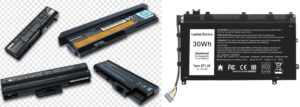
Some features of Lithium-Ion batteries
A ) Lion battery is lighter and the hit is less when the laptop is running. So the possibility of battery bispot is very less.
b) Live cycle of Lion battery is much higher than other batteries. Live cycle means how long charging and discharging can be done, that is, the more charging and discharging can be done, the longer the laptop can be used.
c) Lion battery self-discharge is also reduced. Self-discharge means that even if the user does not use the laptop for a long time, the current in the battery does not completely go down. Lion battery self-discharges about 5 to 10 percent in a month.
According to the company, the battery used in the laptop is of different voltage, ampere and size as shown in the picture below. All laptop batteries have the maximum output voltage, amps and watts written on them. It is known that the more amperes written on the battery, the more backup it provides.
The laptop battery is made by connecting other small batteries together. The number of batteries that are packed together is called a cell battery. As in the picture below, a 6-Cell battery is shown. A cell has at least 3.7 volts or up to 4.5 volts.

3. Laptop Display
A display is an output device that presents information visually. The display used in a laptop can be of the following types.
- LCD : liquid crystal display technology
- LED-light emitting diodes technology
- TFT: Thin Film Transistor technology
- OLED: Organic Light-Emitting Diode technology
- IPS: In-Place Switching technology
- TN: Twisted Nematic technology
TFT, IPS, TN are used in the laptops currently in the market, while the old laptops have LED. The size of the display used in laptops ranges from 10.1 to 18.8 inches.

4. Web Camera
A wave camera is placed in all laptops along with the display (above) to receive video services. Through this camera we can make video calls using the internet.

5. Laptop Hinges
The hinge is connected between the main body of the laptop and the display. Through this, we can rotate the display wherever we want. The texture of hinges used in laptops can be different as shown in the picture below.
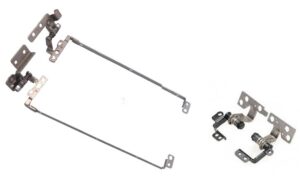
6. LVDS Cable (data cable)
LVDS Cable – Low voltage differential signal is used to connect between laptop display and motherboard. The structure of LVDS Cable can be different as shown in the picture below.
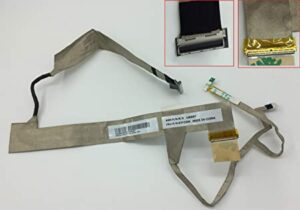
7. FL Card
FL card is used to light the display of the laptop. A tube is placed inside the display to give back light, and to light the same tube, the FL card writes 500 volts and makes it up to 1000 volts AC. This card is placed below the display as shown in the picture below.
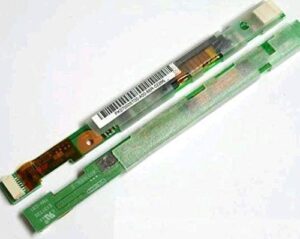
8. Laptop Keyboard
A laptop keyboard is an input device used in a laptop computer. A keyboard for a laptop computer or typewriter is used for typing. The boards used in laptops are shown in the picture below in small size.

9. Touch pad
Everything that is done with a mouse on a desktop computer is done through a touch pad on a laptop. For such a touch system, a board with a touch system IC is placed as shown below on the right.

10. DVD Drive/Optical Drive
As in the desktop, the laptop also has a DVD drive to read/write the CD/DVD. DVD drive is not used in small mini laptops (net books, note books). The DVD drive used in desktop and laptop is as shown below. Currently, the thin size laptops in the market do not have a DVD drive.
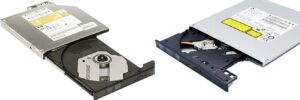
11. Hard disk
A hard disk drive is a drive in which all data is stored. A hard drive or hard disk is a type of technology that stores operating systems, applications and data files. Such hard disk drives are currently used in desktops and laptops with storage capacities ranging from 320 GB (Gigabytes) to 3000 GB (3 TB). Hard disks used in laptops can be of different types as shown below.
11.1.Hard Disk Drives (HDD)
a. pata
PATA (Parallel Advanced Technology Attachment) was developed in the 1980s. The card was placed on the interface parallel (Data output pin) on the hard drive as shown in the figure below. This type of hard drive is currently not available in the market.
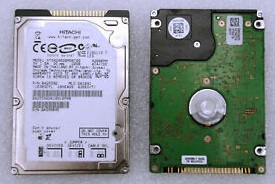
b. Sata
SATA(Serial Advanced Technology Attachment) was created in 2003. A disk is swapped by changing only the interface on the hard drive. There is no significant difference between Sata and Pata hard disk, only the interface is different.
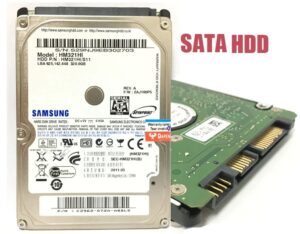
11.2.Solid State Drives (SSD)
SSD stands for Solid State Drive. These discs do not have any moving parts. Instead, all data is stored in a non-volatile flash memory IC. This means that it does not have any heads and disks that need to be moved to read or write data and therefore it is much faster than SSD drives PATA and SATA.
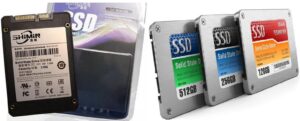
Note: Here both (HDD and SSD) have SATA interface. But NVMe drives are using the PCIe interface.
11.3. NVMe Drive(M.2)
In both NVMe Drive and SSD Drive, the data is stored in the memory chip itself, but the interface for data exchange is kept different so that the speed of NVMe Drive is much faster than SSD Drive. The small size NVMe Drive used in laptops is shown in the picture below.
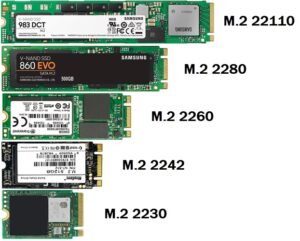
Motherboard
A laptop motherboard is the printed circuit board (PCB) inside the laptop. When we open the cover of the laptop, as shown below, there is a board where all the components are connected. This board is called PCB (Motherboard). This motherboard is the most important part of the laptop.

12. Ram
RAM is used to temporarily store data in a laptop. RAM comes in different capacities and sizes. There are four types of RAM namely DDR1, DDR2, DDR3, DDR4. Some larger sizes are used on desktops and some smaller sizes are used on laptops as shown below.

13. Wi-Fi Card
Wireless LAN card in laptop is used to get wireless internet service. Such cards are inserted into the PCIe slot of the laptop motherboard. The structure of the wireless LAN card is as shown below.

14. Bluetooth Card
Bluetooth card in laptop is used for data transfer. Data can be transferred from a laptop to a mobile phone or any other Bluetooth device.

15. Processor (CPU)
The processor is considered the most important part of desktop and laptop because all the parts on the motherboard work under its instructions and control. These processors are used in laptops of AMD and Intel companies in different speeds and sizes. Core i3 at Intel company. Core i5, Core i7, Core i9, and Xeon lines are widely used.
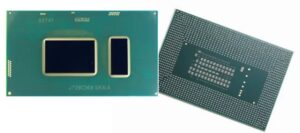
16. Calling system with Fan
Processors used in desktops and laptops heat up while working. As the processor heats up, the laptop becomes slow or the laptop turns off. A cooling fan is used to keep the processor in the desktop or laptop cool while it is working. The cooling system used in the laptop is as shown in the picture below.

17. Speaker
The job of the speaker is to convert electrical audio signals into sound signals. Two (one pair) speakers are placed inside the laptop to convert the electrical audio signal into sound signal. Two speakers are used in laptops as shown in the picture below.
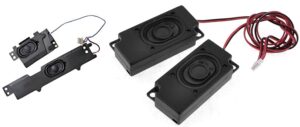
18 .BIOS/CMOS Battery
A BIOS battery is used to back up the BIOS setting (BIOS firmware) and time in desktop and laptop. This type of battery is used in a small laptop and a large size in a desktop.

1.Resistor Resistor
The main function of a resistor is to stop and pass forward the voltage and current according to its capacity. The external structure of the resistor can be different. As the resistor used in the laptop is small in size, it is placed on the PCB board itself, so this type of resistor is also called a chip resistor. Resistors are measured in units of ohms. Resistor is denoted by 'R'. Four types of resistors are mainly used in computers and laptops.
- Value Printed Resistor
- Non Value Printed Resistor
- Fusible Resistor (Fuseable Resistor)
- Array Resistor
a. Value Printed Resistor ( Value Printed Resistor)
A value printed resistor has a value written on top of its outer texture so it is called a value printed resistor. This resistor has two legs. If such resistor is bad then we can put any other resistor of same value. The external structure of this type of resistor is as shown below.
b. Non Value Printed Resistor ( Non Value Printed Resistor)
The value of Non Value Printed Resistor is not written on the outer structure hence it is called Non Value Printed Resistor. The size of this resistor is also smaller than the value printed resistor and usually black in color. The external structure of a non value printed resistor is as shown below.
c. Fuseable Resistor ( Fuseable Resistor)
The external structure of the fuseval resistor is similar to that of the value printed resistor but on the external structure O,K,T,F…. It can also be a non-polar capacitor with or without writing. It is called a fuse even resistor because it works like a fuse. The external structure of this type of resistor is as shown below.
Note: This is actually a fusion. It is called a fuseval resistor because its external structure matches other resistors.
d. Array Resistor ( Array Resistor)
Array Resistor A resistor made by placing two or more resistors in parallel is called an array resistor. The internal structure of such resistors is not connected, only the external structure is connected. In computers and laptops, these resistors are usually found in 2 or 4 packs. Its external structure can have its value written or unwritten. The external structure of this type of resistor is as shown below.

Function of Resistor
a.Value Printed Resistor
b.Non Value Printed Resistor
e.Array Resistor
All of the above resistors look different in appearance, but the function is the same. It will stop the voltage and current according to its capacity and pass it forward. Voltage is given from one leg of this resistor and output from the other leg. such as:

c. Fuseable Resistor
The work of Fuseable Resistor is similar to that of Fuse. If high voltage flows through the fuseable resistor or if there is a voltage shorting in front, it works to protect other goods even if it burns itself. If there is a short in the front part, this resistor itself becomes bad and opens the circuit.
2. CapacitorA product made by placing a non-conductive material between two conductive plates is called a capacitor. A capacitor is also known as a condenser. The function of such capacitors is mainly to filter the current and signal. A capacitor also stores and releases some electrical energy. Resistors are measured in Ohm units while capacitors are measured in Farad units and capacitors are denoted by 'C'. The structure of capacitors used in computers and laptops is SMD type. These capacitors are used in three types, especially in computers and laptops.
- Polar Capacitor (Polar Capacitor)
- Non Polar Capacitor
- Array Capacitor
a. Polar capacitor
A capacitor in which polarity is kept is called a polar capacitor. Polar capacitors are yellow or black in shape as shown in the figure below. This capacitor has markings on one side to distinguish polarity. The pin (leg) on the side which is marked is positive. When changing this type of capacitor, positive (+) and negative (-) should be kept together. The external structure of this type of capacitor is as shown below.
b. Nonpolar capacitor
A nonpolar capacitor is gray in color as shown in the figure below. These nonpolar capacitors range in size from small to large and are widely used in mobile phones. It is called a nonpolar capacitor because it does not have polarity like a polar capacitor. Care should not be taken when connecting these types of capacitors to the circuit, which means that they can be connected by moving the pins. The signal and external structure of this type of capacitor is as shown below.
c. Array capacitor
A capacitor made by connecting two or more non-polar capacitors in parallel is called an array capacitor. Such capacitors used in computers and laptops are usually made by packing 2 or 4. The working of such capacitors is also similar to nonpolar capacitors. Array capacitors are used in computer and laptop motherboards in case of using multiple capacitors of the same value. The external structure of this type of capacitor is as shown below.
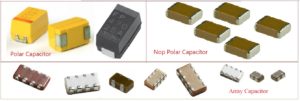
Function of Capacitor
a, Polar Capacitor
The work of this polar capacitor is to filter the DC current. It stays in the polar capacitor even with the voltage accumulated according to its capacity.
b.Non Polar Capacitor
c. Array Capacitor
Both the above capacitors work by filtering the signal according to their capacity. It passes the AC current with a slight stop and stops the DC current completely.
3. Inductor (Coil)A product made by wrapping (winding) an insulating wire is called an inductor or coil. They are built with different cores in their internal structure. Among these cores, if an iron core is built, it generates electromagnetic power and passes the current forward with some resistance according to its capacity. Inductors are also used to destroy or ground unwanted signals. Inductors are measured in Henry units and denoted by 'L'. Two types of inductors are used especially in computers and laptops.
- Iron Core Inductor (Iron Core Coil)
- Feride Core Inductor
a.Iron core inductor
Iron core inductor is made by wrapping iron on the inner structure and insulating wire on the outside. An iron core inductor has a rectangular shape as shown in the figure below. The outer texture of this type of inductor is black in color.
b. Inductor
This type of inductor is made by placing a ferrite core on the inner structure and wrapping the insulator wire on the outside. As shown in the picture below, these inductors of computers and laptops can be seen from the outside and packed (the wire cannot be seen). The outer structure of this type of inductor is round or square in shape and black in color as shown in the picture below.
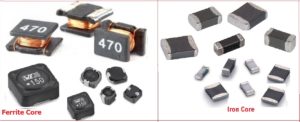
Function of inductor
a.Iron core inductor
In addition to generating electromagnetic force, the iron core inductor filters DC current according to its capacity and passes it forward.
2. Ferride core inductor
A ferrite core is a type of magnetic core made of ferrite. This ferrite core inductor works by filtering the loss frequency and noise coming along with the DC current.
4. DiodeA diode is a semiconductor. It consists of two junctions P and N. In P and N junctions, the pin (leg) from the P type part is called the anode and the pin from the N type part is called the cathode. Such diodes are marked on the outside to identify the cathode pin. The diodes are of very large size used in radios and televisions, while the small SMD size is used to stick on the motherboard of computers and laptops. Diodes are denoted by D and V. There are five types of diodes used mainly in computers and laptops.
Note: A substance that cannot flow easily like a good conductor and does not flow at all like a poor conductor is called a semiconductor.
- Single Rectifier Diode-Two Legs
- Two Packup Rectifier Diode (Two Packup Diode-Three Legs)
- Four pack up Rectifier Diode-Five Legs
- Light Emitting Diode (Light Emitting Diode -LED)
- Zener Diode
a. Single rectifier diode (two legs)
Single Rectifier Diode Rectifier diode has rectangular shape in black color. The two legs of this diode are called cathode and anode. A slight blackish marking is done on one side to distinguish the cathode pin. A single rectifier diode used in a laptop is as shown in the figure below.
b. To – backup rectifier diode
A two-pack rectifier diode is made by packing two single rectifier diodes together. Its internal structure is similar to that of a full-wave rectifier diode. Inside it two single rectifier diodes are packed as shown in the figure below and the work is same as a single rectifier. Two-backup diodes can be connected with common anode and common cathode or differently. A two-backup rectifier diode can be easily checked with a multimeter according to its internal structure. The structure of this type of diode is as shown below.
c . Four-backup rectifier diode
A four-pack rectifier diode has five legs in black and is made by packing four single rectifier diodes inside it. This diode has two legs on the top side and three legs on the bottom side. The external color of the diodes is also usually black. The structure of four-backup rectifier diode is as shown below.
d. Ziner diode and TVS diode
The external structure of Zener diode is similar to that of single rectifier diode but it is smaller in size. The external structure and operation of the TVS diode is almost the same as that of the Zener diode. This diode does not have markings towards one leg as in the Zener. TVS diode is used for protection.
e. Light Emitting Diode
A light emitting diode is a diode that emits light. This type of diode emits light when a supply voltage is applied. Such diodes are placed inside the display to provide backlight. Its external structure is as shown below.
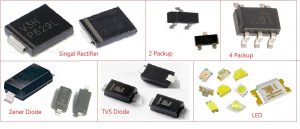
Function of Diode
a. Single Rectifier Diode (Two Legs)
b. Two Packup Diode (Three Legs)
c. Four Packup Diode (Five Legs)
All the above three diodes have the same function, only their external appearance is different. Its job is to change the AC current to DC and stop it if the reverse voltage comes. Reverse voltage is when the positive(+) is replaced by the negative(-) voltage or the negative(-) is replaced by the positive(+) voltage.
d. Zener Diode/TVS Diode
Both these diodes have the same external structure but inside the TVS diode two Zener diodes are packed. A Zener diode forwards a voltage equal to its own voltage. This diode can be used in parallel or series.
e. LED (Light Emitting Diode)
This diode is a light placed on the motherboard as a power and charging indicator and inside the display to illuminate.
5. CrystalA material that produces a calque frequency of a certain value is called a crystal. When a supply voltage is given to it, it vibrates mechanically and produces a frequency of a certain value. Two types of crystals are used especially in laptops. On the outside of the Crystal is written the Frequency it produces as a Body.
- Reference Rrystal -RF
- RTC (Real Time Clock -RTC)
a. R. F. Crystal
The outer texture of the RF crystal is a charpate signing (shiny) metal or charpate black color and the texture is written outside the frequency it produces. In laptops, such RF crystals are placed around Clock Generator and Lan Driver IC.
(i)14.318 Mhz Crystal
Based on the call given by this crystal, the processor of computer and laptop carries different information. If this crystal is damaged, computers and laptops will not turn on as the processor will not be able to do any further processing. The frequency it produces is written on the texture itself as shown in the figure below. In computers and laptops it is placed near Clock Generator. The outer texture of this crystal is as shown below.
(ii)25.0Mhz Crystal
Like the above crystal, this crystal also produces a frequency of its own specific value. The frequency produced by this crystal is given to the Lan Driver IC in computers and laptops.
b. R.T.C.
The outer texture of RTC crystals may be somewhat scaly, black, purple, or even covered with steel. Some laptops have black color like RF crystal. The RTC is placed around the SIO or South bridge IC on the laptop motherboard. The outer texture of this crystal is as shown below.

Function of Crystal
a.RF Crystal
The frequency produced by the RF crystal is called the CLK frequency. The frequency produced by it is used to carry various information and signals.
b.RTC(Real Time Clock)
The CLK frequency produced by the RTC is used to run the time on the laptop.
6. TransistorA transistor is also made up of a PN junction similar to a diode. A diode has only one PN junction, whereas a transistor has two PN junctions. Transistors are used for various purposes. In particular, transistors are used for signal amplifiers, voltage regulators, voltage switching and oscillators. This is described below.
1. A signal amplifier
The function of a signal amplifier transistor is to amplify a small input signal. Such transistors are used in all electronic devices. Transistor amplifying any signal only increases the amplitude of the signal and does not affect the wavelength of the signal. The signal input of the signal amplifier transistor is always given from the base pin.
2. Switching voltage
Among the three pins of such a transistor, a biasing voltage is applied to the base pin to operate it. So biasing current flows between the collector and emitter of the transistor with the base pin of the transistor. Thus, when current flows in the collector and emitter, any device in the other part can be turned on/off.
3. A voltage regulator
Fluctuating currents and voltages cannot be fed directly to any sensitive ICs. Supplying such an uneven voltage causes the IC to not perform well and deteriorates quickly. Therefore, the job of making current and voltage in the same way is called regulator. A regulator transistor is used to create such a uniform current or voltage.
Two types of transistors are used in computers and laptops, bipolar and mosfet.
- Bipolar transistor
- MOSFET TRANSISTOR
a.Bipolar transistor
A bipolar transistor is made up of two PN junctions. This transistor has three pins (legs) drawn out and the legs are named base, collector and emitter. The base pin of the transistor controls the current flowing in the transistor while the collector does the work of collecting ie this pin collects the current and the emitter does the job of spreading the current. Bipolar transistors have two types of internal structure NPN and PNP. Its internal structure is as shown below.
A voltage switching bipolar transistor is black in color with three legs. This transistor has one leg on the top side and two legs on the bottom side. A transistor placed for voltage switching is called a switching transistor. The external structure of this transistor is as shown in the figure below.
The voltage regulator bipolar transistor is black in color with one big leg on the top side and three small legs on the bottom side. A transistor of this type is kept constant by a voltage regulator. The external structure of this regulator regulator bipolar transistor is as shown in the figure below.

b. MOSFET transistor
A transistor made from one of the P/N semiconductors is called a mosfet transistor. The three legs of a mosfet transistor are called drain, source and gate. In particular, mosfet transistors are used for voltage regulation and voltage switching with 3, 6 or 8 legs. The external structure of this mosfet is rectangular in shape as shown below.

Voltage regulator mosfet transistors are used on laptop motherboards with 8 pins. This type of mosfet can be Singal or Dual (Pack up) as shown in the picture below.
8 Legs Single Mosfet
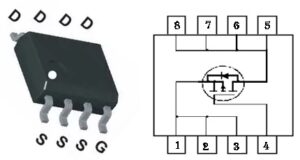
8 Legs Dual(Pack up) Mosfet

A three-pin MOSFET transistor is used for voltage switching on the motherboard in laptops. This type of MOSFET transistor can have 3 or 6 legs as shown in the figure below.
3 Legs Mosfet

6 Legs Dual(Pack up) Mosfet
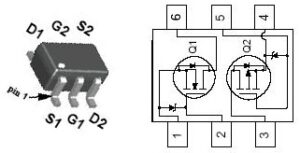
Function of Transistor
a.Transistor for voltage regulator
The process of making unregulate (uneven) voltage to regulate (equal) is called voltage regulator. The voltage regulator Transistor works to make the voltage that has decreased and become the same.
b.Voltage Switching Transistor
Giving the voltage only when it is needed is called voltage switching. Switching is called switching of the transistor that is kept for the day by switching only when the voltage is required. Bipolar or Mosfet any transistor can be used to switch the voltage.
What is the difference between Bipolar Transistor and Mosfet Transistor ?
Any Bipolar or Mosfet Transistor can be used to regulate the voltage. Compared to Bipolar Transistor, Mosfet Transistor has the ability to work at a very fast speed without generating heat, so Mosfet is considered better than Bipolar.
7. ON/OFF Switch (2 & 4 Pin)The switch used to turn the laptop on and off is called on and off. We press and release such switches for some time. Thus, when the switch is pressed, the ground on one pin of the switch is connected to the other pin and reaches the SIO IC.

8 . Fuse
A device used to protect electrical circuits is called a fuse. These fuses come in many sizes and types, the external structure of the fuse can be written as LF, TF, F, E, M, X, L.. or as shown in the figure below.

Function of the fuse
When the current flows to the front section through the fuse, if it takes more load than its capacity or if there is a short circuit in front, it will burn itself and save the part in front of it from being completely damaged. In computers and laptops, such fuses are often used in the way of voltage from one section to another section.
9 . EIT Protection ( Ethernet Isolation Transformer)
EIT Protection is also known as Ethernet Isolation Transformer. It is placed near the LAN connector of the motherboard to protect it from the harmful effects of electromagnetic force and to completely block DC currents.

The external structure of the ICs used in the laptop is of the following type.
1. BGA (Ball Grid Architecture/Array)
2. SMD (Surface Mount Device Type)
1. BGA (Ball Grid Architecture/Array)
The soldering balls of the BGAIC are placed at the bottom of the IC as shown in the figure below. BGAIC is mostly used in laptops. Pin count of B.G.A.I.C.s is calculated as shown in the figure below. Here we have given A,B,C,D,E,F,G,H,J,K on horizontal line and 1,2,3,4,5,6,7 on vertical line now we have given pin name by matching vertical and horizontal line. is given As shown in the left picture, there is a cut point at the bottom of the IC. The pin just above the same cut has the name A horizontally and the number 1 vertically, this pin is called A1. Similarly all the pins of the IC are counted. The structure of BGAICs is as shown below.

2.SMD (Surface Mount Device Type)
S.Yam DICs are called S.Y.M.D because the structure of S.Y.M.D.I.C. is visible from the outside with pins on two sides or on all four sides and is attached to the PCB. ICs with this type of structure are more commonly used in Chinese laptops. When counting the pins of such ICs, as shown in the picture below, a side arrow marked (round or white) with the IC turned towards itself should be counted to the right, considering the pin just below as number 1.

1. South Bridge
South Bridge IC is also known as ICH-Input/Output Controller Hub. This South Bridge IC has a very important role on the motherboard. It acts as an interface between the Input/Output on the laptop motherboard. Like USB Port, Audio Driver Chips, Lan Driver Chips, SIO Chips, BIOS, PCIe Slot, Hard Disk Drive, DVD Drive….etc.
To identify the South Bridge IC on the laptop motherboard, the Northbridge or Processor (CPU) is placed near this IC and the external structure of the South Bridge IC is as shown in the picture below.
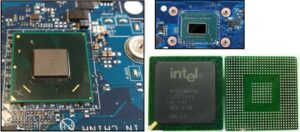
2. North Bridge
North Bridge IC is also known as GMCH- Graphics Memory Controllers Hub or Graphic chip. Processor (CPU) is placed near this North Bridge IC. The outer structure of the North bridge IC is similar to the South bridge in a large size as shown in the figure below. Currently, all laptop motherboards in the market have the North Bridge IC packed inside the Processor (CPU). The main function of North Bridge is to work between CPU, Memory and Display (Graphics).
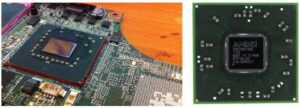
3 . Super I.O. ( Super IO IC)
Super I.O.I.C. South Bridge in square shape is smaller in size than I.C. Laptop motherboards have super I.O from companies like Winbond, ENE, NVOTON,SMSC,SMC, ITE, ALI, MISC, VIA, SIS, UMC…….. It is widely used. SIO chip Number :- (PC97338, PC87392,FDC7N869, FDC37N958, LPC47N227, LPC47N267 PC87591S/ PC 87591L / PC 97317IBW/PC 87393 VGJ PC87591E ETC )

The main function of Super IOIC is to turn on and off all the power sections placed on the laptop motherboard. Super IO is directly connected to the South bridge, Keyboard and Touch pad on the laptop motherboard. The on/off switch of the laptop is connected to the Super IOC. When we press the switch for some time, the Super IOIC gets a trigger and enables the oscillator ICs of the power sections placed on the motherboard. If the super I.O.I.C is bad, the laptop is completely dead because the oscillator ICs do not get the Enable command. When the laptop does not turn on, the most common problem is this IC.
4. BIOS IC
A flash memory is placed on the motherboard of the laptop which is called (Basic input/output system) BIOS IC. Bios ICs are used by different companies like Winbond,Dell,Intel,ASUS,IBM,AT,SST,Amtel.. BIOS memory 8 pin is used on laptop motherboard. The external structure and pin layout of this type of memory is as shown below.
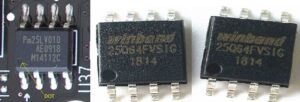
BIOS IC Pin description
1. CS# Chip Select pin 2. SO Serial Data Output pin 3. WP# Write Protection pin 4. Ground 5. SI Serial Data Input pin 6. SCLK Clock Input Pin 7. HOLD# To pause device 8. VCC
It acts as an interface between software and hardware. When we turn on the laptop, the CPU copies the file stored in the BIOS and detects system devices such as Video display, Keyboard, touch, Hard disks drive, Optical disc drive... and other hardware. Firmware (Award, Ami, IBM, Phoenix..) is programmed in this BIOS chip.
5. Audio Driver IC
Audio driver IC is often used on the motherboard of computers and laptops, usually Realtek company's square shape with legs around. The external structure of the audio driver IC is as shown below.
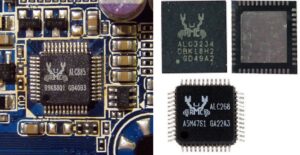
The main function of this audio IC is to convert the digital audio signal received from the south bridge into analog. Similarly, it filters the analog signal coming from the mic of the audio port, converts it to a digital signal by slightly amplifying it, and gives it to the South Bridge.
6. Audio Amplifier IC
The amplifier IC is placed near the speaker connector and audio driver IC on the laptop motherboard. The external structure of this audio amplifier IC can be in Square or Rectangle shape as shown below.

The function of this audio amplifier IC is to amplify the audio signal given by the audio driver IC and give it to the speaker. We hear it only after the speaker converts the electric wave into sound.
7. Clock Generator IC
The Call Generator IC is placed near the 14.318 Mhz crystal on the motherboard of computers and laptops. The external structure of this IC can be Square or Rectangle shape as shown below.

The Clock Generator IC on the motherboard of computers and laptops produces a certain type of timing signal (Clock Signal) which is like a Square Wave. Through this CLK produced by the Clock Generator IC, the CPU carries various information.
8. Lan driver IC ( Lan driver IC )
The LAN driver IC is placed near the 25.0 Mhz crystal on the motherboard of computers and laptops. This IC is mostly from Realtek company and the external structure can be in Square or Rectangle shape. As this IC is related to the Internet, it is placed near the Lan Connector on the motherboard of computers and laptops. It drives the South Bridge by switching the data coming and going from the Internet cable.
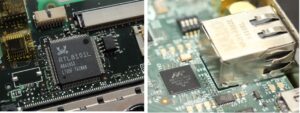
9. Oscillator IC
Oscillator IC's external structure can be in Square or Rectangle shape and this IC is placed around mosfets. Oscillator ICs are placed to drive the MOSFETs used in the power sections of the laptop motherboard. Oscillator IC works to give a pulse to gate pin of mosfet. The voltage output by the mosfet is controlled by this oscillator IC itself. The external structure of oscillator IC is as shown below.
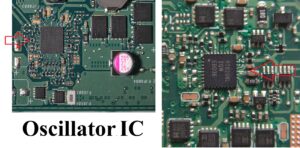
10. Voltage Regulator IC
Voltage regulator ICs can be used on laptop motherboards with 3, 5 and 6 pins. A voltage regulator IC is used on the laptop motherboard to provide a fixed positive voltage regulator. Laptops are more commonly used with small five legs as shown in the picture below. As in MOSFET, the control signal is given by some other section at Adj.Pin to control the output voltage in the voltage regulator IC.

The pinout of a five-pin voltage regulator IC is as shown in the figure below.
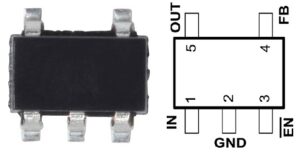

Ready to Learn!!!
Regular Price: $605.54 USD.
Special Offer Only $169.95 USD


